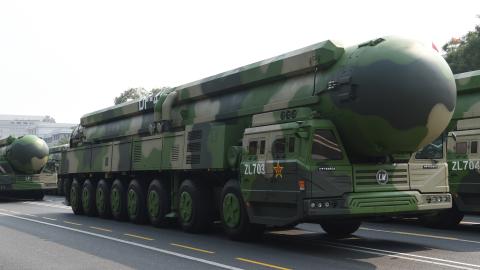China is expanding its nuclear arsenal, from a few hundred weapons to roughly 1,000 by 2030. It may have 1,550 warheads or more by the mid-2030s—the limit agreed to by Russia and America in a deal originally signed between them in 2010. This Chinese buildup is changing geopolitics. The American-Russian bipolar nuclear system, which has dominated the nuclear balance for over half a century, is evolving into a less stable tripolar system that risks undermining long-standing pillars of deterrence and triggering a nuclear arms race.
All this comes as America prepares to modernize its ageing “triad” of nuclear-weapons delivery systems (land-based and submarine-launched ballistic missiles, and long-range bombers). China’s gambit raises questions over how best to proceed, as a tripolar system will erode several critical pillars of deterrence that proved effective in the bipolar system.
One pillar of deterrence, “parity”—a rough equivalence in nuclear forces—has been a cornerstone of all arms agreements between America and Russia over the past half-century. It is rooted in the belief that if neither power enjoys a significant advantage, each is less likely to use its nuclear weapons. As a senior Russian official declared in 2021, parity “stabilizes the entire system of international relations”. The need to maintain parity is particularly important for America, which seeks not only to deter nuclear attacks against itself, but also against crucial allies such as Australia, Germany, Japan and South Korea that lack nuclear forces of their own.
China’s decision to “superpower-size” its nuclear arsenal suggests Beijing seeks nuclear parity with America and Russia. Parity can be enjoyed by both rivals in a bipolar system. But it cannot be achieved in a tripolar system, because it is not possible for each member to match the combined arsenals of its two rivals. Any attempt to do so risks triggering an arms race with no possible end state, or winner.
A similar problem exists with respect to another pillar of the bipolar system, known as “assured destruction”. It holds that deterrence is strengthened when a country’s nuclear forces can survive an all-out surprise attack and still retain enough weapons to inflict unacceptable damage on its opponent’s society in a retaliatory strike. During the cold war one American estimate concluded that 400 weapons would suffice as an assured-destruction capability against such an attack by the Soviet Union.
But what about maintaining an assured-destruction capability against both Russia and China? America will need a substantially larger cache of weapons so that a surviving force could provide an assured destruction capability in a tripolar system. As with maintaining parity, this state of affairs could cause Moscow and Beijing to build up their arsenals too, resulting in an open-ended arms race.
Some argue that maintaining parity and assured destruction does not matter much, noting that China maintained a “minimal” nuclear deterrent of a few hundred weapons for decades. But when it comes to nuclear weapons, it seems Beijing has never been comfortable being a distant third to Russia and America. Others say that half of America’s deployed nuclear weapons could be placed on submarines, which are exceedingly difficult to detect. But this assumes that America’s submarines will remain undetectable over service lives lasting half a century, despite the proliferation of increasingly advanced detection technology. It also ignores the fact that, at any given moment, roughly half of American submarines may be in port where they are not stealthy sharks, but sitting ducks.
Although the shift from a bipolar to a tripolar nuclear system risks destabilizing the fragile balance of power, we have at least some understanding of how things will change. Yet we are only in the early stages of thinking through the tripolar system’s characteristics and their implications. A similar intellectual enterprise early in the bipolar era by some of the West’s best strategic thinkers paid great dividends for America’s security, and that of its allies. This kind of effort is needed now.
Fortunately there is time for this, as it will take the better part of a decade before China reaches the force levels of America and Russia. There is no need to rush pell-mell into new arms-control agreements or to expand America’s arsenal. The first step is to understand the dynamics of a tripolar nuclear system and what they mean for security. Only then should America consider whether or not, for example, to sign a follow-on agreement to the New START treaty (the Russian-American deal limiting each side to 1,550 warheads) when it expires in 2026.
America should keep its options open and its powder dry. This means energetically pursuing the administration’s plans to modernize the country’s triad of nuclear delivery systems until America has a clearer picture of how best to ensure its security in a tripolar system. The modernization program, even in its most expensive years, would probably consume less than 7% of the defense budget.
Modernization creates the possibility for serious negotiations with the Chinese and the Russians, who are already modernizing their nuclear forces. They will have far less incentive to negotiate if America allows its triad to age into obsolescence.
Proceeding with triad modernization will also enable America to expand its arsenal should China and Russia blow past the New START treaty’s 1,550-warhead limit. Exercising this option will require a “warm” industrial base with active production lines. As the Pentagon is discovering after transferring large quantities of munitions to Ukraine, its inability to boost production to meet unanticipated needs risks compromising America’s security, and that of its allies. Hence the importance of triad modernization as the best way to hedge against an uncertain future.















